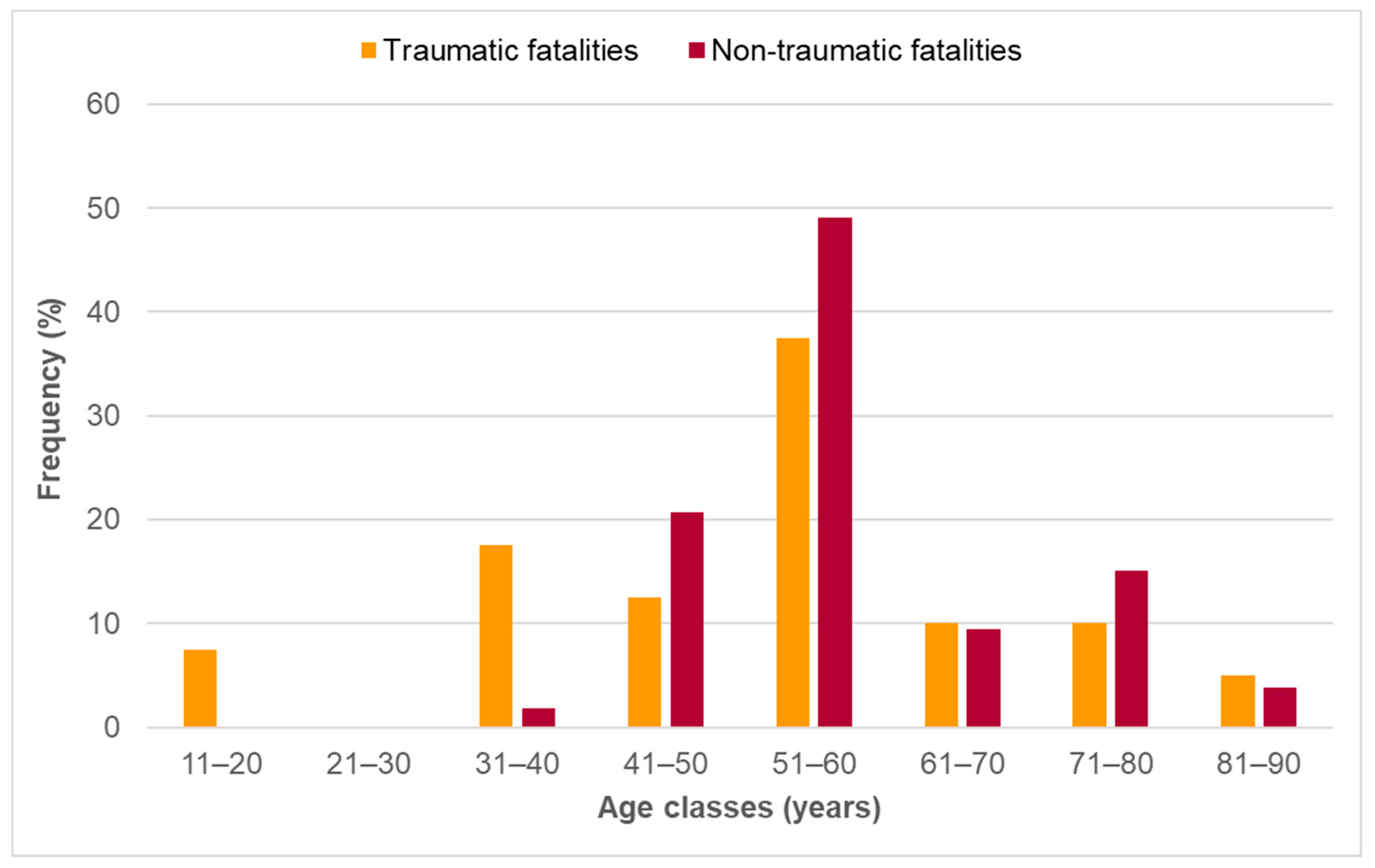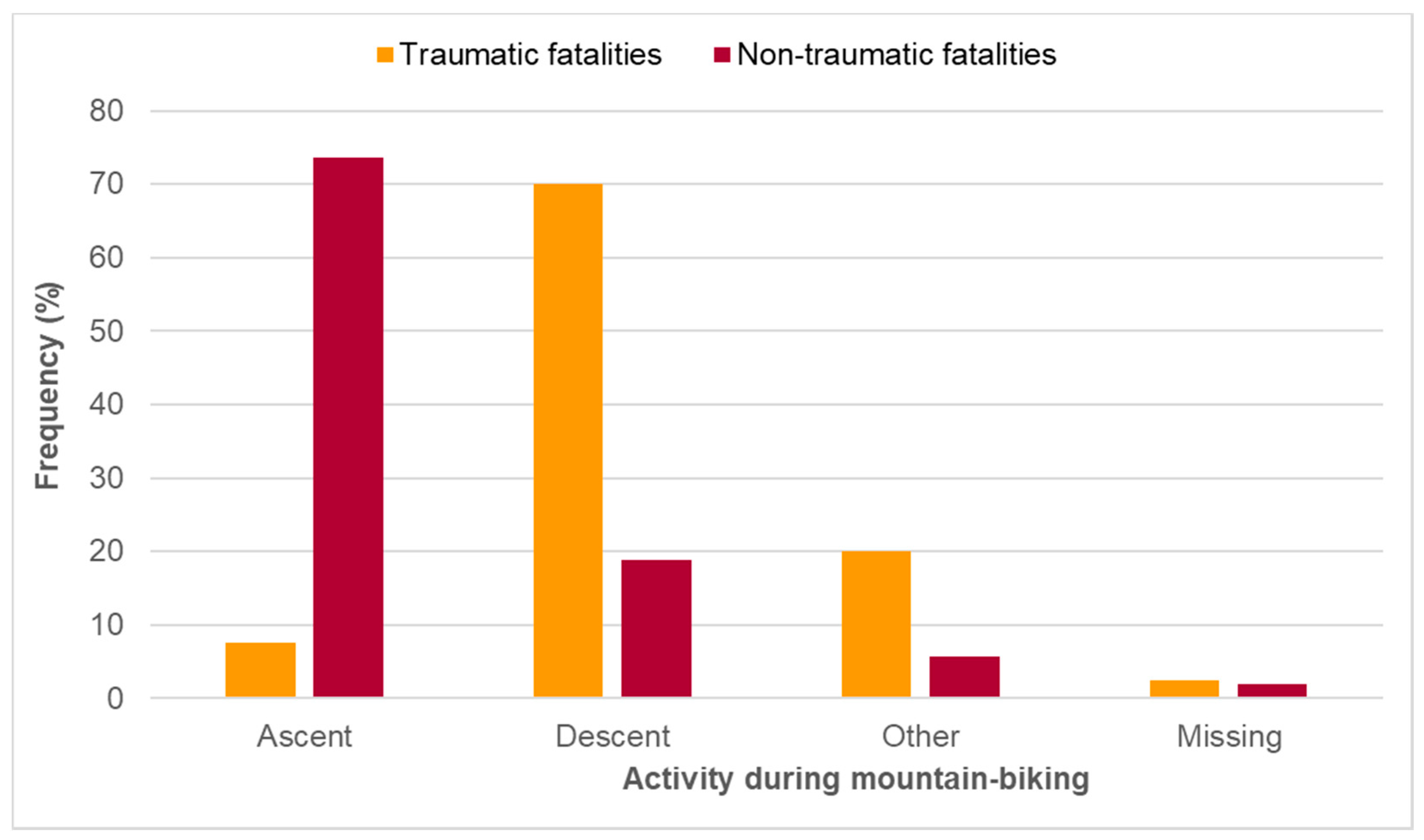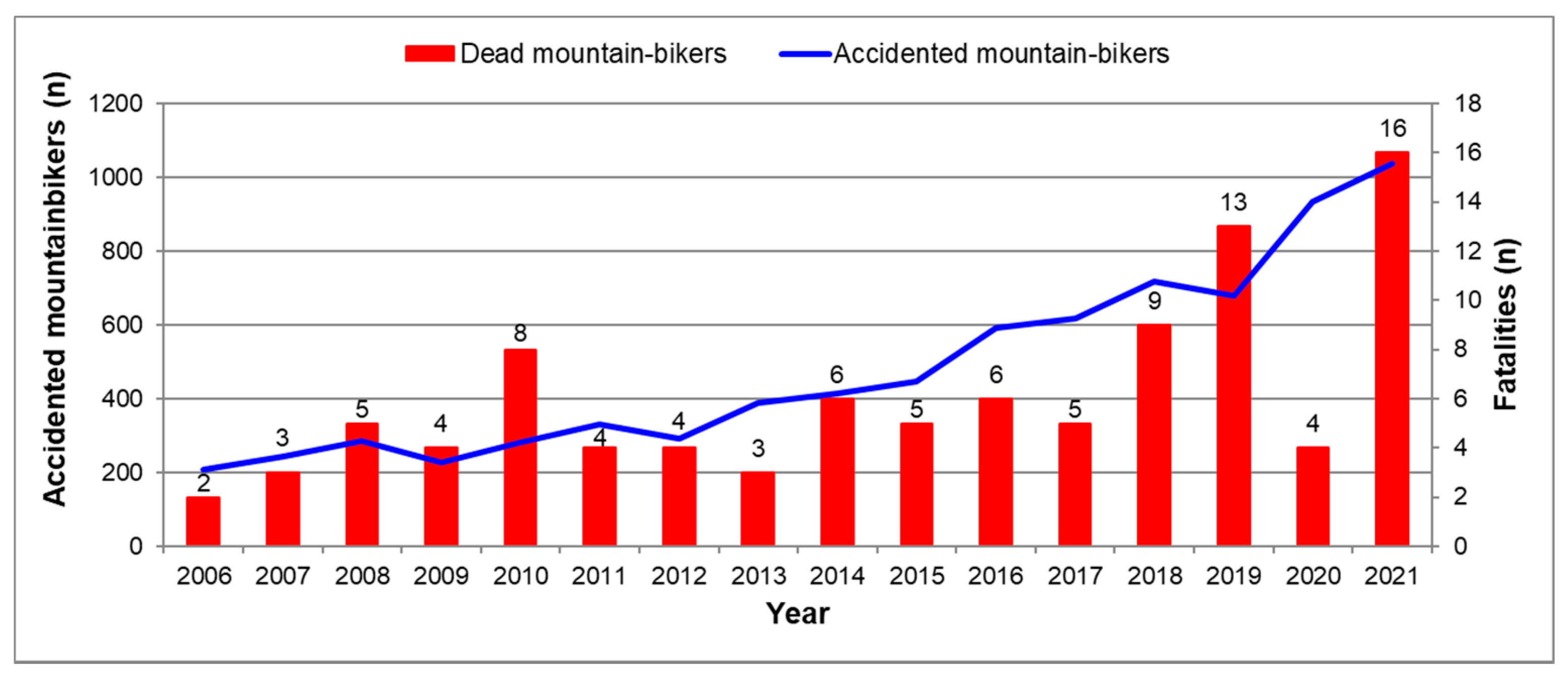Mortality in Recreational Mountain-Biking in the Austrian Alps: A Retrospective Study over 16 Years
Abstract
:1. Introduction
2. Materials and Methods
2.1. Study Design
2.2. Data Collection and Primary Data Source
2.3. Data Transfer
2.4. Data Screening and Data Selection
2.5. Statistics
3. Results
3.1. Characteristics of Accidents
3.2. Characteristics of Victims
3.3. Fatal Accidents over Time and Mortality Index
4. Discussion
4.1. Characteristics of Accidents
4.2. Characteristics of Victims
4.3. Fatal Accidents over Time and Mortality Index
4.4. Suggestions for the Prevention of Fatal Accidents
4.5. Limitations
5. Conclusions
Author Contributions
Funding
Institutional Review Board Statement
Informed Consent Statement
Data Availability Statement
Acknowledgments
Conflicts of Interest
References
- Caine, D.J.; Young, K.; Provance, A.J. Pediatric and Adolescent Injury in Mountain Biking. Res. Sports Med. 2018, 26, 71–90. [Google Scholar] [CrossRef]
- The Future of Cycle Tourism in the Alps. Available online: https://www.alp-net.eu/wp-content/uploads/2020/04/theALPS-Bike-Study-2015.pdf/ (accessed on 15 August 2019).
- Mountainbike-Fahren—Häufigkeit in Der Freizeit in Deutschland 2018–2022. Available online: https://de.statista.com/statistik/daten/studie/171142/umfrage/haeufigkeit-von-mountainbike-fahren-in-der-freizeit/ (accessed on 16 June 2019).
- Mountain Biking Statistics 2020. Available online: https://shredtrail.com/mountain-biking-statistics/ (accessed on 16 June 2019).
- Anzahl Verkaufter Fahrräder in Österreich nach Modellen in den Jahren 2013 bis 2016. Available online: https://de.statista.com/statistik/daten/studie/455982/umfrage/verkaufte-fahrraeder-in-oesterreich-nach-modellen/ (accessed on 26 August 2019).
- Anzahl Verkaufter Elektro-Fahrräder in Österreich von 2008 Bis 2021. Available online: https://de.statista.com/statistik/daten/studie/435607/umfrage/absatz-von-e-bikes-in-oesterreich/ (accessed on 26 June 2022).
- Fahrrad Verkaufszahlen 2019 VSSÖ. Available online: https://www.vsso.at/fahrrad-verkaufszahlen-2019/ (accessed on 26 June 2022).
- Ergebnisbericht-MTB-Umfrage-Alpenverein-2021. Available online: https://www.alpenverein.at/portal_wAssets/docs/bergsport/sicheramberg/mountainbike/mtb-umfrage-2021/Ergebnisbericht-MTB-Umfrage-Alpenverein-2021.pdf/ (accessed on 26 August 2022).
- Hamer, M.; Chida, Y. Active Commuting and Cardiovascular Risk: A Meta-Analytic Review. Prev. Med. 2008, 46, 9–13. [Google Scholar] [CrossRef] [PubMed]
- Rasmussen, M.G.; Grøntved, A.; Blond, K.; Overvad, K.; Tjønneland, A.; Jensen, M.K.; Østergaard, L. Associations between Recreational and Commuter Cycling, Changes in Cycling, and Type 2 Diabetes Risk: A Cohort Study of Danish Men and Women. PLoS Med. 2016, 13, e1002076. [Google Scholar] [CrossRef] [PubMed]
- Burr, J.F.; Drury, C.T.; Ivey, A.C.; Warburton, D.E.R. Physiological Demands of Downhill Mountain Biking. J. Sports Sci. 2012, 30, 1777–1785. [Google Scholar] [CrossRef]
- Ooms, L.; Veenhof, C.; de Bakker, D.H. The Start2Bike Program Is Effective in Increasing Health-Enhancing Physical Activity: A Controlled Study. BMC Public Health 2017, 17, 606. [Google Scholar] [CrossRef] [PubMed]
- Roberts, L.; Jones, G.; Brooks, R. Why Do You Ride?: A Characterization of Mountain Bikers, Their Engagement Methods, and Perceived Links to Mental Health and Well-Being. Front. Psychol. 2018, 9, 1642. [Google Scholar] [CrossRef] [PubMed]
- Kirkwood, L.; Ingram-Sills, L.; Taylor, M.D.; Malone, E.; Florida-James, G. Immune Response of Elite Enduro Racers to Laboratory and Racing Environments: The Influence of Training Impulse and Vibration. Int. J. Environ. Res. Public. Health 2021, 18, 4603. [Google Scholar] [CrossRef]
- Oosthuyse, T.; Bosch, A.N.; Kariem, N.; Millen, A.M.E. Mountain Bike Racing Stimulates Osteogenic Bone Signaling and Ingesting Carbohydrate-Protein Compared With Carbohydrate-Only Prevents Acute Recovery Bone Resorption Dominance. J. Strength Cond. Res. 2021, 35, 292–299. [Google Scholar] [CrossRef]
- Dodwell, E.R.; Kwon, B.K.; Hughes, B.; Koo, D.; Townson, A.; Aludino, A.; Simons, R.K.; Fisher, C.G.; Dvorak, M.F.; Noonan, V.K. Spinal Column and Spinal Cord Injuries in Mountain Bikers: A 13-Year Review. Am. J. Sports Med. 2010, 38, 1647–1652. [Google Scholar] [CrossRef]
- Ansari, M.; Nourian, R.; Khodaee, M. Mountain Biking Injuries. Curr. Sports Med. Rep. 2017, 16, 404–412. [Google Scholar] [CrossRef]
- Roberts, D.; Ouellet, J.-F.; Sutherland, F.; Kirkpatrick, A.; Lall, R.; Ball, C. Severe Street and Mountain Bicycling Injuries in Adults: A Comparison of the Incidence, Risk Factors and Injury Patterns over 14 Years. Can. J. Surg. 2013, 56, E32–E37. [Google Scholar] [CrossRef]
- Ortega, F.B.; Ruiz, J.R.; Gutiérrez, A.; Castillo, M.J. Extreme Mountain Bike Challenges May Induce Sub-Clinical Myocardial Damage. J. Sports Med. Phys. Fit. 2006, 46, 489–493. [Google Scholar]
- Kim, P.T.W.; Jangra, D.; Ritchie, A.H.; Lower, M.E.; Kasic, S.; Brown, D.R.; Baldwin, G.A.; Simons, R.K. Mountain Biking Injuries Requiring Trauma Center Admission: A 10-Year Regional Trauma System Experience. J. Trauma Inj. Infect. Crit. Care 2006, 60, 312–318. [Google Scholar] [CrossRef] [PubMed]
- Gatterer, H.; Niedermeier, M.; Pocecco, E.; Frühauf, A.; Faulhaber, M.; Menz, V.; Burtscher, J.; Posch, M.; Ruedl, G.; Burtscher, M. Mortality in Different Mountain Sports Activities Primarily Practiced in the Summer Season—A Narrative Review. Int. J. Environ. Res. Public. Health 2019, 16, 3920. [Google Scholar] [CrossRef] [PubMed]
- Pocecco, E.; Wafa, H.; Rausch, L.K. Mortalität beim Mountainbiken. Analyse: Berg, Österreichisches Kuratorium Für Alpine Sicherheit. Analyse 2022, in press. [Google Scholar]
- Ruedl, G.; Bilek, H.; Ebner, H.; Gabl, K.; Kopp, M.; Burtscher, M. Fatalities on Austrian Ski Slopes During a 5-Year Period. Wilderness Environ. Med. 2011, 22, 326–328. [Google Scholar] [CrossRef]
- Faulhaber, M.; Pocecco, E.; Niedermeier, M.; Ruedl, G.; Walter, D.; Sterr, R.; Ebner, H.; Schobersberger, W.; Burtscher, M. Fall-Related Accidents among Hikers in the Austrian Alps: A 9-Year Retrospective Study. BMJ Open Sport—Exerc. Med. 2017, 3, e000304. [Google Scholar] [CrossRef]
- Posch, M.; Schranz, A.; Lener, M.; Burtscher, M.; Ruedl, G. Incidences of Fatalities on Austrian Ski Slopes: A 10-Year Analysis. Int. J. Environ. Res. Public. Health 2020, 17, 2916. [Google Scholar] [CrossRef]
- Faulhaber, M.; Ruedl, G.; Schneider, F.; Walter, D.; Sterr, R.; Schobersberger, W.; Schwendinger, F.; Pocecco, E. Characteristics of Victims of Fall-Related Accidents during Mountain Hiking. Int. J. Environ. Res. Public. Health 2020, 17, 1115. [Google Scholar] [CrossRef]
- Ruedl, G.; Bauer, R.; Pfanner, M.; Rein, F.; Burtscher, M.; Benedetto, K. Ursachen Und Risikofaktoren von Verletzungen Im Skiurlaub. Dtsch. Z. Für Sportmed. 2013, 2013, 52–56. [Google Scholar] [CrossRef]
- Ruedl, G.; Abart, M.; Ledochowski, L.; Burtscher, M.; Kopp, M. Self Reported Risk Taking and Risk Compensation in Skiers and Snowboarders Are Associated with Sensation Seeking. Accid. Anal. Prev. 2012, 48, 292–296. [Google Scholar] [CrossRef] [PubMed]
- Twisk, D.; Stelling, A.; Van Gent, P.; De Groot, J.; Vlakveld, W. Speed Characteristics of Speed Pedelecs, Pedelecs and Conventional Bicycles in Naturalistic Urban and Rural Traffic Conditions. Accid. Anal. Prev. 2021, 150, 105940. [Google Scholar] [CrossRef] [PubMed]
- Hall, C.; Hoj, T.H.; Julian, C.; Wright, G.; Chaney, R.A.; Crookston, B.; West, J. Pedal-Assist Mountain Bikes: A Pilot Study Comparison of the Exercise Response, Perceptions, and Beliefs of Experienced Mountain Bikers. JMIR Form. Res. 2019, 3, e13643. [Google Scholar] [CrossRef] [PubMed]
- Schlemmer, P.; Barth, M.; Schnitzer, M. Comparing Motivational Patterns of E-Mountain Bike and Common Mountain Bike Tourists. Curr. Issues Tour. 2020, 23, 1186–1190. [Google Scholar] [CrossRef]
- Durchschnittsalter Der Bevölkerung in Österreich von 2012 Bis 2022. Available online: https://de.statista.com/statistik/daten/studie/217730/umfrage/durchschnittsalter-der-bevoelkerung-in-oesterreich/ (accessed on 26 June 2022).
- Burtscher, M.; Pachinger, O.; Schocke, M.F.H.; Ulmer, H. Risk Factor Profile for Sudden Cardiac Death during Mountain Hiking. Int. J. Sports Med. 2007, 28, 621–624. [Google Scholar] [CrossRef]
- Burtscher, M.; Ponchia, A. The Risk of Cardiovascular Events during Leisure Time Activities at Altitude. Prog. Cardiovasc. Dis. 2010, 52, 507–511. [Google Scholar] [CrossRef]
- Faulhaber, M.; Pocecco, E.; Posch, M.; Ruedl, G. Accidents during Mountain Hiking and Alpine Skiing—Epidemiological Data from the Austrian Alps Unfälle Beim Bergwandern Und Alpinskifahren—Epidemiologische Daten Aus Den Österreichischen Alpen. Dtsch. Z. Für Sportmed. 2020, 71, 293–299. [Google Scholar] [CrossRef]
- Impellizzeri, F.M.; Marcora, S.M. The Physiology of Mountain Biking. Sports Med. Auckl. NZ 2007, 37, 59–71. [Google Scholar] [CrossRef]
- Mueller, T.; Ruedl, G.; Ernstbrunner, M.; Plachel, F.; Fröhlich, S.; Hoffelner, T.; Resch, H.; Ernstbrunner, L. A Prospective Injury Surveillance Study on Ski Touring. Orthop. J. Sports Med. 2019, 7, 2325967119867676. [Google Scholar] [CrossRef]
- Kronisch, R.L.; Pfeiffer, R.P. Mountain Biking Injuries: An Update. Sports Med. Auckl. NZ 2002, 32, 523–537. [Google Scholar] [CrossRef]
- Høye, A. Bicycle Helmets—To Wear or Not to Wear? A Meta-Analyses of the Effects of Bicycle Helmets on Injuries. Accid. Anal. Prev. 2018, 117, 85–97. [Google Scholar] [CrossRef]
- Posch, M.; Burtscher, J.; Ruedl, G.; Pocecco, E.; Burtscher, M. Unchanged Fatality Rate on Austrian Ski Slopes during the COVID-19 Lockdown. Int. J. Environ. Res. Public. Health 2022, 19, 7771. [Google Scholar] [CrossRef]
- van Aert, G.J.J.; van der Laan, L.; Boonman-de Winter, L.J.M.; Berende, C.A.S.; de Groot, H.G.W.; Boele van Hensbroek, P.; Schormans, P.M.J.; Winkes, M.B.; Vos, D.I. Effect of the COVID-19 Pandemic during the First Lockdown in the Netherlands on the Number of Trauma-Related Admissions, Trauma Severity and Treatment: The Results of a Retrospective Cohort Study in a Level 2 Trauma Centre. BMJ Open 2021, 11, e045015. [Google Scholar] [CrossRef]
- Burtscher, M.; Pachinger, O.; Mittleman, M.A.; Ulmer, H. Prior Myocardial Infarction Is the Major Risk Factor Associated with Sudden Cardiac Death during Downhill Skiing. Int. J. Sports Med. 2000, 21, 613–615. [Google Scholar] [CrossRef]
- Burtscher, J.; Millet, G.P.; Gatterer, H.; Vonbank, K.; Burtscher, M. Does Regular Physical Activity Mitigate the Age-Associated Decline in Pulmonary Function? Sports Med. Auckl. NZ 2022, 52, 963–970. [Google Scholar] [CrossRef] [PubMed]
- Aleman, K.B.; Meyers, M.C. Mountain Biking Injuries in Children and Adolescents. Sports Med. Auckl. NZ 2010, 40, 77–90. [Google Scholar] [CrossRef]




| Frequency | ||
|---|---|---|
| (n) | (%) | |
| Region (n = 97) | ||
| Burgenland | 0 | 0.0 |
| Carinthia | 6 | 6.2 |
| Lower Austria | 8 | 8.2 |
| Salzburg | 19 | 19.6 |
| Styria | 12 | 12.4 |
| Tyrol | 34 | 35.1 |
| Upper Austria | 13 | 13.4 |
| Vienna | 1 | 1.0 |
| Vorarlberg | 4 | 4.1 |
| Time of year: month (n = 97) | ||
| March | 2 | 2.1 |
| April | 5 | 5.2 |
| May | 11 | 11.3 |
| June | 25 | 25.8 |
| July | 11 | 11.3 |
| August | 16 | 16.5 |
| September | 17 | 17.5 |
| October | 10 | 10.3 |
| Time of week (n = 97) | ||
| Weekday | 59 | 60.8 |
| Weekend | 38 | 39.2 |
| Time of day (n = 97) | ||
| Early morning (12:01 a.m.–8:00 a.m.) | 1 | 1.0 |
| Morning/afternoon (8:01 a.m.–04:00 p.m.) | 77 | 79.4 |
| Evening (4:01 p.m.–8:00 p.m.) | 17 | 17.5 |
| Night (8:01 p.m.–12:00 a.m.) | 2 | 2.1 |
| Lighting conditions (n = 92) | ||
| Daylight | 87 | 94.6 |
| Twilight | 1 | 1.1 |
| Darkness | 4 | 4.3 |
| Weather conditions (n = 93) | ||
| Sunny | 76 | 81.7 |
| Cloudy | 12 | 12.9 |
| Rainy | 4 | 4.3 |
| Snowy | 1 | 1.1 |
| Altitude (n = 89) | ||
| <500 m | 3 | 3.4 |
| 500–1000 m | 33 | 37.1 |
| 1000–1500 m | 39 | 43.8 |
| 1500–2000 m | 14 | 15.7 |
| Type of trail (n = 89) | ||
| Asphalt road | 1 | 1.1 |
| Drive or forest way | 64 | 71.9 |
| Marked hiking trail or small path | 13 | 14.6 |
| Pathless terrain | 7 | 7.9 |
| Bike-park | 2 | 2.2 |
| Other | 2 | 2.2 |
| Frequency | ||
|---|---|---|
| (n) | (%) | |
| Cause of accident | ||
| Fall on the way | 16 | 40.0 |
| Fall down hillside | 12 | 30.0 |
| Fall in a creek/river | 10 | 25.0 |
| Collision | 2 | 5.0 |
| Injury location | ||
| Head | 7 | 17.5 |
| Neck/cervical spine (CS) | 6 | 15.0 |
| Back/spine without CS | 4 | 10.0 |
| Whole body | 16 | 40.0 |
| Missing | 7 | 17.5 |
| Injury type | ||
| Fracture | 11 | 27.5 |
| Luxation | 1 | 2.5 |
| Internal injury | 2 | 5.0 |
| Polytrauma | 19 | 47.5 |
| Missing | 7 | 17.5 |
Publisher’s Note: MDPI stays neutral with regard to jurisdictional claims in published maps and institutional affiliations. |
© 2022 by the authors. Licensee MDPI, Basel, Switzerland. This article is an open access article distributed under the terms and conditions of the Creative Commons Attribution (CC BY) license (https://creativecommons.org/licenses/by/4.0/).
Share and Cite
Pocecco, E.; Wafa, H.; Burtscher, J.; Paal, P.; Plattner, P.; Posch, M.; Ruedl, G. Mortality in Recreational Mountain-Biking in the Austrian Alps: A Retrospective Study over 16 Years. Int. J. Environ. Res. Public Health 2022, 19, 11965. https://doi.org/10.3390/ijerph191911965
Pocecco E, Wafa H, Burtscher J, Paal P, Plattner P, Posch M, Ruedl G. Mortality in Recreational Mountain-Biking in the Austrian Alps: A Retrospective Study over 16 Years. International Journal of Environmental Research and Public Health. 2022; 19(19):11965. https://doi.org/10.3390/ijerph191911965
Chicago/Turabian StylePocecco, Elena, Hamed Wafa, Johannes Burtscher, Peter Paal, Peter Plattner, Markus Posch, and Gerhard Ruedl. 2022. "Mortality in Recreational Mountain-Biking in the Austrian Alps: A Retrospective Study over 16 Years" International Journal of Environmental Research and Public Health 19, no. 19: 11965. https://doi.org/10.3390/ijerph191911965
APA StylePocecco, E., Wafa, H., Burtscher, J., Paal, P., Plattner, P., Posch, M., & Ruedl, G. (2022). Mortality in Recreational Mountain-Biking in the Austrian Alps: A Retrospective Study over 16 Years. International Journal of Environmental Research and Public Health, 19(19), 11965. https://doi.org/10.3390/ijerph191911965








